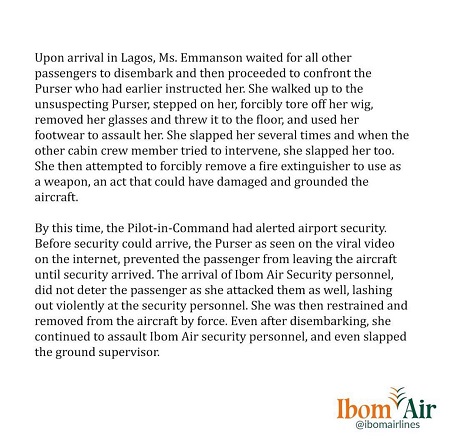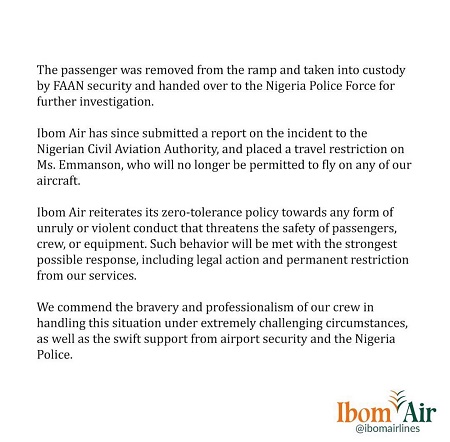A disturbing incident unfolded aboard an Ibom Air flight when a female passenger was forcibly removed mid-flight under chaotic circumstances, sparking outrage and heated debate online.

Table of Contents
Incident Summary
According to multiple accounts, the episode began during the descent just before landing, when the passenger refused repeated instructions from cabin crew to switch off her mobile phone. Tensions escalated when she allegedly engaged in a heated argument with airline personnel and then slapped a flight attendant—an act confirmed by body camera footage delineating the confrontation.
At that point, airport security and crew intervened. What followed was a dramatic and forceful ejection from the aircraft. Despite her resistance, the woman was dragged down the aisle, leading to notable distress and injury. Video footage shows the flight attendant attempting to prevent her exit before security stepped in and tore part of her clothing in the process.
Once removed, she was escorted into a waiting airport bus and taken into custody. She now faces multiple charges, including assault on aviation staff, non-compliance with safety instructions aboard an aircraft, and resisting lawful authority.
Also Read: Asantehemaa Nana Konadu Yiadom III Passes on at 91
Public Backlash & Questions of Protocol
The incident has ignited widespread criticism. Many questioned the necessity of dragging the passenger arguing that a calmer removal after landing could have avoided the spectacle altogether. The question echoed across social media: “Could they not have deboarded her peacefully on the ground?”
Critics likened the scene to an affront to basic human decency, pointing to the torn clothing and public humiliation she suffered. They argue that duty must not degrade personal dignity or respect, even during enforcement of flight rules. The incident has become a lightning rod for discussions on respect, authority, and how service staff should handle nonviolent defiance particularly in the confined, emotionally fraught environment of an aircraft.




Perspective from Aviation Safety & Passenger Rights
From an aviation safety standpoint, crew members are trained to maintain control during potentially destabilizing incidents in flight. The directive to power down mobile devices during landing is legally mandated by aviation authorities to avoid interference with navigational equipment.
When a passenger physically assaults crew, airlines are required to prioritize safety. That said, excessive force or public humiliation violates standards of passenger rights and professional conduct. Legal experts stress that trained de-escalation should always remain the priority especially in the skies, where a misstep could endanger everyone aboard.
Also Read: Stonebwoy Plans Vybz Kartel Link-Up
Reflections from Passengers & Observers
Fellow passengers onboard reportedly witnessed the struggle with shock. Descriptions of the scene capture not only conflict but palpable fear and helplessness: “We were landing when all hell broke loose,” one observer recounted. “It wasn’t just law enforcement it was almost a public lynching.”
Voices on social platforms reacted strongly. Harsh language has been used around hashtags like #IbomAirScandal and #AviationJustice, particularly aimed at the airline’s procedures. Hashtags have called for independent review, compulsory video transparency in such incidents, and training in conflict resolution for staff.
What’s at Stake?
- Airline Reputation and Trust: The fallout from such a public and disturbing incident erodes customer confidence and risks long-term damage to the carrier’s credibility.
- Safety vs. Civility: Striking the right balance remains critical accountability for violent behavior must be enforced, yet human dignity must not be dismissed.
- Policy Implications: This could lead to renewed scrutiny from aviation regulators and passenger rights advocates. Revised training standards, external oversight, and clear escalation protocols may be demanded.
- Legal Ramifications: The woman now faces possible criminal prosecution. Depending on the legal outcome, civil lawsuits for emotional and physical harm are also possible, particularly if the removal method is found disproportionate.
A Disturbing Lesson in Aviation Conduct
This incident should prompt urgent reflection across the aviation sector. Crew safety is paramount but so is preserving passenger rights and humane treatment. With videos already going viral, public pressure for transparent processes, respectful handling of defiance, and clear escalation protocols is mounting.
Ultimately, the hope is that this unsettling moment becomes a catalyst for meaningful reform ensuring future conflicts are resolved with professionalism rather than turning into traumatic spectacles.


